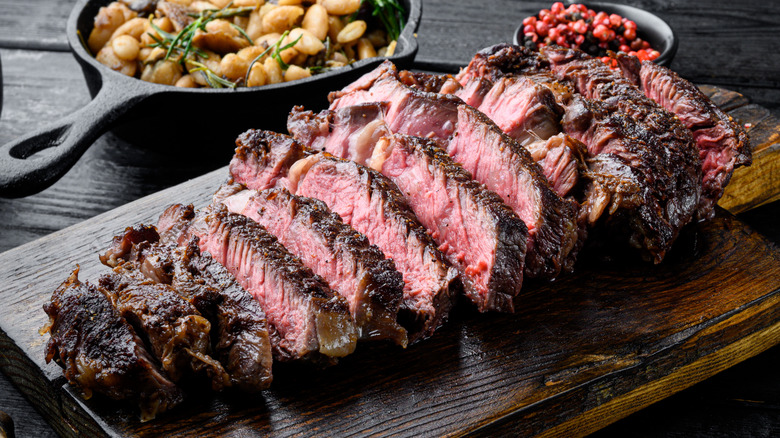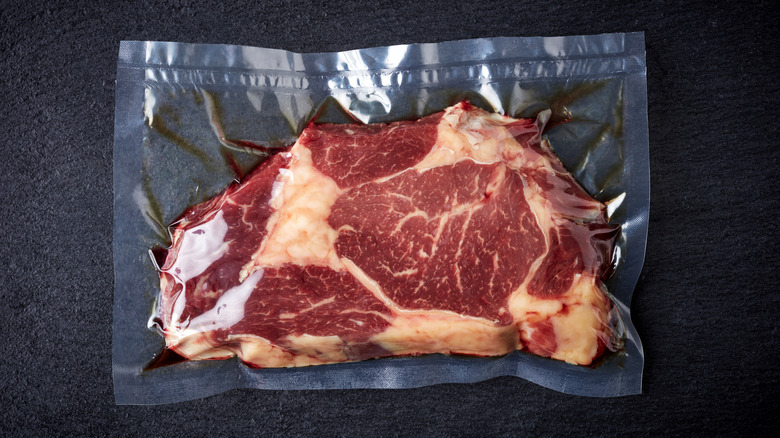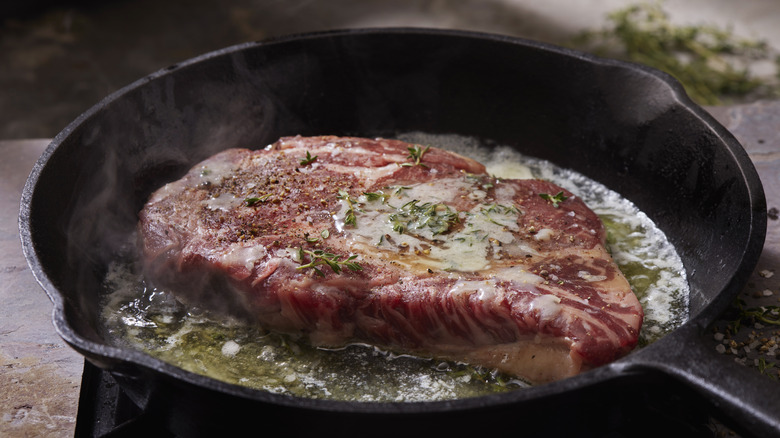Sous Vide Vs. Reverse Sear: Which Method Yields The Better Steak?
In the contest to produce the best homemade steak possible, two contenders have been duking it out for years: sous vide and the reverse sear. Testing and technology have led chefs to these similar methods, which both use low-and-slow cooking to help get the target temperature precisely right. They are both relatively simple to pull off and achievable for home cooks, as well.
While both methods have their advantages, the reverse sear has one clear upside that elevates it above sous vide in our eyes: it gives you a better crust. While sous vide cooks in a sealed pouch in water, the reverse sear steak is brought to temperature in the oven. That means that while the sous vide steak is stewing in its own juices, the exterior of the reverse sear steak is drying out. Both will still keep temperatures low enough for the inside to stay moist, but that dry exterior makes a world of difference when the steak hits a hot pan. Less moisture on the steak's surface means more browning, and browning is where something as simple as a steak gets much of its flavor.
Cooking sous vide steak
Sous vide cooking can still produce a fantastic steak, and it has several advantages over a reverse sear. Of course, you have the downside of needing a dedicated gadget, but it gives you a precision that no other method (the reverse sear included) can touch. The essential element for the sous vide method is the temperature-controlled water, usually achieved by using an immersion circulator. By only surrounding your steak with water at a specific temperature, you can cook it to precisely that point with zero risk of it becoming overdone. With an oven, even at a low temperature, you can dry out your steak if you don't get the timing right.
The specificity of temperature you get from using sous vide is unparalleled, so not only will your steak not overcook, you can get exactly the doneness level you want. Because it's so gentle, sous vide can prepare a very evenly heated steak, so you can expect never to see a ring of gray well-done meat surrounding a red center. Sous vide means juicy steak at exactly the right temperature, done with little effort and little risk of error.
However, it does have a few problems. One is time, as the very low cooking temperature means it can take hours to produce a steak. The other is that sealing the steak as it cooks prevents moisture from evaporating; steaks need that exterior browning, and excess moisture inhibits that browning, even if you pat it dry.
Cooking a reverse sear steak
Instead of using a water bath, the reverse sear uses an oven set to around 250 degrees Fahrenheit to slowly raise the steak's temperature. While you can't set the exact degree of doneness you want like sous vide, the oven method is still slow enough that you have a wide margin for error and can identify the moment the steak needs to come out with a meat thermometer. While a reverse sear steak is quicker to make than sous vide, you do run the risk of going past your target temperature, which means you have to stay on top of it more. An extra minute or two won't make a huge difference, but it's not as foolproof as sous vide.
That small chance of overcooking is worth it, though, because the crust and flavor you get from reverse searing are superior. Like dry-aging a steak in the fridge, the extended air exposure in the oven will dehydrate the outside before you sear it in the pan. The steak crust from a reverse sear will be deeply brown, crispy, and full of new tastes from the Maillard reaction. Less moisture also means the browning happens faster since no water needs to evaporate, which reduces the risk of overcooking in the pan. The cons of a reverse sear are minimal and easily accounted for, and the upside is so good that it should be your go-to method for making steak.


